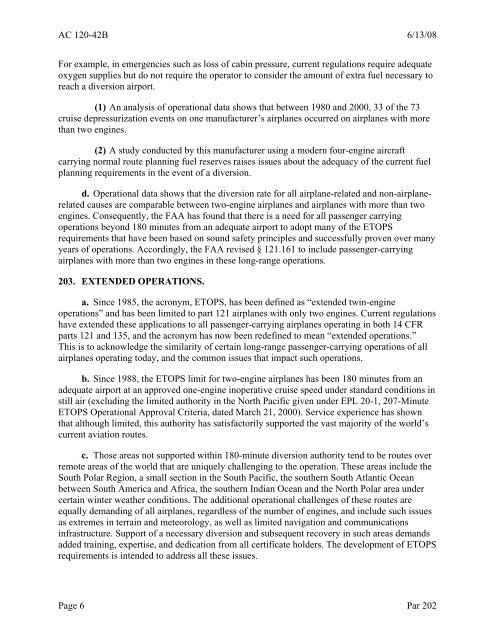AC 120-42B ETOPS and Polar Ops - Code7700
AC 120-42B ETOPS and Polar Ops - Code7700
AC 120-42B ETOPS and Polar Ops - Code7700
You also want an ePaper? Increase the reach of your titles
YUMPU automatically turns print PDFs into web optimized ePapers that Google loves.
<strong>AC</strong> <strong>120</strong>-<strong>42B</strong> 6/13/08For example, in emergencies such as loss of cabin pressure, current regulations require adequateoxygen supplies but do not require the operator to consider the amount of extra fuel necessary toreach a diversion airport.(1) An analysis of operational data shows that between 1980 <strong>and</strong> 2000, 33 of the 73cruise depressurization events on one manufacturer’s airplanes occurred on airplanes with morethan two engines.(2) A study conducted by this manufacturer using a modern four-engine aircraftcarrying normal route planning fuel reserves raises issues about the adequacy of the current fuelplanning requirements in the event of a diversion.d. Operational data shows that the diversion rate for all airplane-related <strong>and</strong> non-airplanerelatedcauses are comparable between two-engine airplanes <strong>and</strong> airplanes with more than twoengines. Consequently, the FAA has found that there is a need for all passenger carryingoperations beyond 180 minutes from an adequate airport to adopt many of the <strong>ETOPS</strong>requirements that have been based on sound safety principles <strong>and</strong> successfully proven over manyyears of operations. Accordingly, the FAA revised § 121.161 to include passenger-carryingairplanes with more than two engines in these long-range operations.203. EXTENDED OPERATIONS.a. Since 1985, the acronym, <strong>ETOPS</strong>, has been defined as “extended twin-engineoperations” <strong>and</strong> has been limited to part 121 airplanes with only two engines. Current regulationshave extended these applications to all passenger-carrying airplanes operating in both 14 CFRparts 121 <strong>and</strong> 135, <strong>and</strong> the acronym has now been redefined to mean “extended operations.”This is to acknowledge the similarity of certain long-range passenger-carrying operations of allairplanes operating today, <strong>and</strong> the common issues that impact such operations.b. Since 1988, the <strong>ETOPS</strong> limit for two-engine airplanes has been 180 minutes from anadequate airport at an approved one-engine inoperative cruise speed under st<strong>and</strong>ard conditions instill air (excluding the limited authority in the North Pacific given under EPL 20-1, 207-Minute<strong>ETOPS</strong> Operational Approval Criteria, dated March 21, 2000). Service experience has shownthat although limited, this authority has satisfactorily supported the vast majority of the world’scurrent aviation routes.c. Those areas not supported within 180-minute diversion authority tend to be routes overremote areas of the world that are uniquely challenging to the operation. These areas include theSouth <strong>Polar</strong> Region, a small section in the South Pacific, the southern South Atlantic Oceanbetween South America <strong>and</strong> Africa, the southern Indian Ocean <strong>and</strong> the North <strong>Polar</strong> area undercertain winter weather conditions. The additional operational challenges of these routes areequally dem<strong>and</strong>ing of all airplanes, regardless of the number of engines, <strong>and</strong> include such issuesas extremes in terrain <strong>and</strong> meteorology, as well as limited navigation <strong>and</strong> communicationsinfrastructure. Support of a necessary diversion <strong>and</strong> subsequent recovery in such areas dem<strong>and</strong>sadded training, expertise, <strong>and</strong> dedication from all certificate holders. The development of <strong>ETOPS</strong>requirements is intended to address all these issues.Page 6 Par 202
















